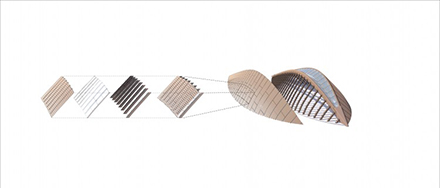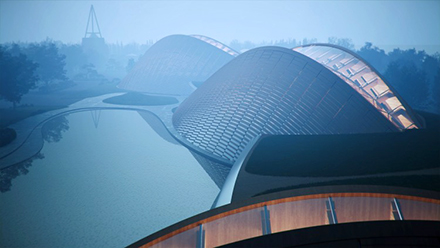MAD Architects based in China and led by Ma Yansong, have unveiled the design of their latest project; “The Eyes of Sanxingdui” for the Sanxingdui Ancient Shu Cultural Heritage Museum. Source: Timberbiz
The project sees MAD place a cluster of scattered wooden structures above the dense greens and clear waters of the ancient landscape.
The new buildings merge with the existing landscape to form a new environment, which simultaneously celebrates the ancient mysteries of the Sanxingdui civilization and connects with the area’s timeless natural environment through a restrained, humble volume.
The result is a park which acts as an urban and cultural public space where humanity and nature, the past and the future, can converge.
The project site is located in the western area of Guanghan City, Sichuan Province. Filled with unearthed cultural relics dating from approximately 4500-2800 years ago, the site’s archaeology is rooted in the echoes of ancient cities, ancient states, and the ancient Shu culture of southwest China.
The Sanxingdui site has jointly applied with the nearby Jinsha site to be recognized as a world cultural heritage site by UNESCO
The Sanxingdui Museum Park is located at the northeast corner of the site’s core protected region, covering a total area of 90,000 square meters. The design includes urban planning, a new museum and visitor reception service centre, and an overall landscape strategy.
Upon its completion, this world-class thematic museum will accommodate activities like collection, display, protection and research for the excavated cultural relics from the Sanxingdui site.
MAD’s design consists of a cluster of six wooden buildings scattered in an east-west direction. East of Xiangxin Road is the site’s first building; a Visitor Centre covering a floor area of 5,830 square meters. Extending westwards, five buildings of various scales form the new museum. In total, the new museum covers an area of about 30,000 square meters, with a construction area of 28,650 square meters.
The Sanxingdui site laid host to a number of cultural relics, including longitudinal bronze eye masks and large bronze standing figures, many of which adopt exaggerated, strange, ornate shapes.
After sunset, the six buildings are enlivened as torch-like eyes behind the bronzeware and golden masks of Sanxingdui, uniting the spirits and forms, allowing people in the museum to wander between history and the future.
During the day, the building’s wooden facade echoes the park’s natural landscape. The timber structure’s large spans allow for open, rich column-free interior spaces inside the building, yielding maximum flexibility for exhibition layouts. Meanwhile, the rooftop skylight provides natural light for the museum.
A journey through the museum begins at the main entrance of the visitors’ centre, before proceeding to a viewing hall which offers an introduction into the culture of Sanxingdui. Visitors then progress towards an underground corridor to the museum’s first floor entrance hall. From here, the exhibition halls are connected to each other through a south-facing glass corridor, through which visitors can enjoy the ever-changing landscape as they move through the complex.






